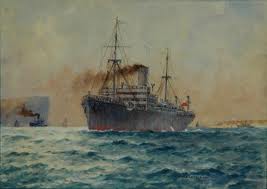
Ship HMAT BARAMBAH.
55th Battalion

Ship HMAT BARAMBAH.
55th Battalion
The 55th Battalion  - (colours) -
was raised in Egypt on 12 February 1916 as part of the “doubling” of the AIF. Half of its recruits were Gallipoli veterans from the 3rd Battalion, and the other half, fresh reinforcements from Australia. Reflecting the composition of the 3rd, the 55th was predominantly composed of men from New South Wales. The battalion became part of the 14th Brigade of the 5th Australian Division.
- (colours) -
was raised in Egypt on 12 February 1916 as part of the “doubling” of the AIF. Half of its recruits were Gallipoli veterans from the 3rd Battalion, and the other half, fresh reinforcements from Australia. Reflecting the composition of the 3rd, the 55th was predominantly composed of men from New South Wales. The battalion became part of the 14th Brigade of the 5th Australian Division.
Arriving in France on 30 June 1916, the battalion entered the frontline trenches for the first time on 12 July and fought its first major battle at Fromelles a week later. The battle was a disaster, resulting in heavy casualties across the division. Although in reserve, the 55th was quickly committed to the attack and eventually played a critical role, forming the rearguard for the 14th Brigade’s withdrawal. Despite its grievous losses the 5th Division continued to man the front in the Fromelles sector for a further two months.
After a freezing winter manning trenches in the Somme Valley, in early 1917 the 55th Battalion participated in the advance that followed the German retreat to the Hindenburg Line. It was spared the assault but did, however, defend gains made during the second battle of Bullecourt. Later in the year, the AIF’s focus of operations switched to the Ypres sector in Belgium. The 55th’s major battle here was at Polygon Wood on 26 September.
With the collapse of Russia in October 1917, a major German offensive on the Western Front was expected in early 1918. This came in late March and the 5th Division moved to defend the sector around Corbie. The 14th Brigade took up positions to the north of Villers-Bretonneux and held these even when the village fell, threatening their flanks.
Once the German offensive had been defeated, the Allies launched their own offensive in August 1918. The 14th Brigade did not play a major role in these operations until late in the month, but its actions were critical to the capture of Péronne, which fell on 2 September. The 55th fought its last major battle of the war, St Quentin Canal, between 29 September and 2 October 1918. For his valour during this action Private John Ryan was awarded the Victoria Cross. - Ed Note - "Interesting to note mention of Private John Ryan, who lived in the Blowering valley and went to school on a property situate north of "Yukon" that Mr Lund was to purchase and move his family to in later years Also the fact Private Sidney John Liddell (John Stephenson's grandfather) was killed in one of the battles mentioned. His wife Mary Kathleen Brannock also went to the same school in the later 1890's which was built on the same property that John's parents relocated to at about the same time that the Lund's relocated to the Yellowin area. The Lund's travelled passed the gates of these properties very time they travelled to Tumut and back".
The battalion was resting out of the line when the Armistice was declared on 11 November. The progressive return of troops to Australia for discharge resulted in the 55th merging with the 53rd Battalion on 10 March 1919. The combined 53/55th Battalion, in turn, disbanded on 11 April. - (Ref- http://www.awm.gov.au/units/unit_11242.asp).